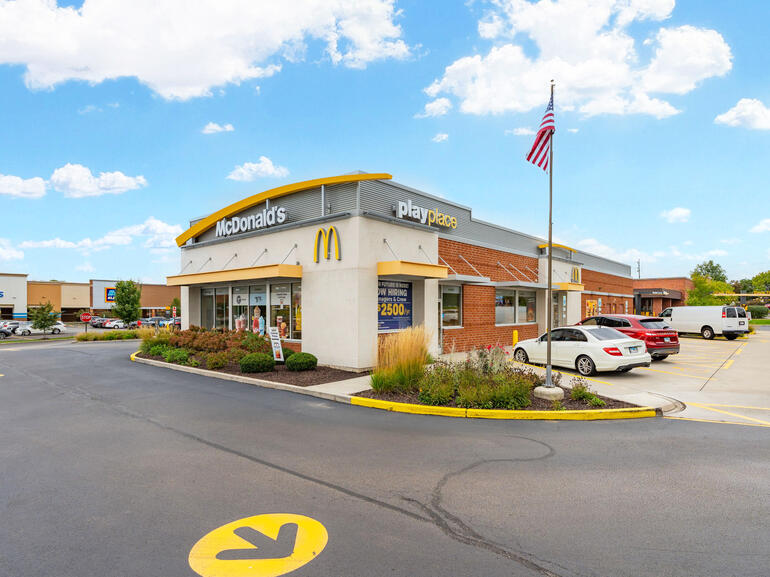Battling for the Fast-Food Crown: Is McDonald’s Still the King of Quick Service Restaurants?

For decades, McDonald’s has reigned supreme in the quick service restaurant (QSR) space – a brand practically synonymous with convenience, value and operational consistency. But as the QSR landscape evolves, the golden arches are facing increasingly fierce competition. A new class of fast-food contenders – Chick-fil-A, Raising Cane’s, Whataburger and Jollibee – is challenging the status quo, capturing market share and outperforming McDonald’s on several critical fronts.
For investors in the single-tenant net lease market, this shifting dynamic presents a compelling opportunity to reassess which brands are truly wearing the crown. Here’s how these rising stars are reshaping the QSR hierarchy and why they’re attracting heightened attention from real estate investors.
Challengers to the Throne
Each of these fast-growing QSR brands brings a unique playbook as they push for success.
Chick-fil-A continues to redefine what it means to be a category leader. With a sharp focus on prime site selection and high-traffic, smaller-footprint locations, the brand posted an industry-leading Average Unit Volume (AUV) of $7.48 million in 2023. While its average annual rent has climbed near $200,000, Chick-fil-A still manages a rent-to-sales ratio of just 2.30%, outperforming McDonald’s 2.58%. The brand’s combination of superior sales performance and commitment to high quality real estate makes it McDonald’s most formidable competitor.
Raising Cane’s has emerged as a force through simplicity and loyalty. In mid-2024, the brand reported 350 restaurants in their development pipeline and continued a 15.5-year streak of same-store sales growth. Furthermore, the brand reached an AUV of just under $5.70 million in 2023. Known for its streamlined menu and cult following, the chain is expanding aggressively into suburban markets – including college towns and secondary metros – often where McDonald’s already operates. Double drive-thru lanes and a focus on throughput have helped Raising Cane’s swiftly surpass McDonald’s year-over-year sales in markets across the country.
Whataburger is quietly outperforming expectations. Though still largely regional, the brand surpasses McDonald’s in AUV and typically operates on a smaller square footage basis. It has evolved into a reliable ground lease investment with a growing presence in the southern U.S. While its rent-to-sales ratio is higher than McDonald’s at 3.90%, Whataburger's performance in concentrated areas shows its potential as a premier brand in the QSR arena.
Jollibee is leaning into its cultural roots and global ambition. Backed by a $366 million investment in 2024, the Filipino fast-food giant is rapidly expanding in the U.S. while maintaining a strong international presence. Its 2023 AUV of $4.37 million has outpaced both McDonald’s and Whataburger, despite their lack of American operating history. Though limited net lease inventory exists today, Jollibee’s aggressive U.S. expansion signals fresh opportunities for investors looking ahead.
Cap Rates Signal Momentum Shift
From a net lease investor’s perspective, cap rates offer a revealing snapshot of brand strength and risk tolerance. McDonald’s, long considered the gold standard, posted a 4.39% average cap rate in first quarter 2025 – the highest since 2018. Meanwhile, investor confidence in challengers is rising fast.
- Raising Cane’s saw a 12-basis-point decline.
- Chick-fil-A cap rates dropped 30 basis points last quarter.
- Whataburger led with a 36-basis point dip.
McDonald’s still benefits from an unparalleled operating history, but its cap rate advantage is declining as newer brands demonstrate faster growth, greater investor enthusiasm and strong real estate fundamentals that solidify deals on market.
McDonald’s Is Still Royal
Despite intensifying competition, McDonald’s isn’t fading into the background. In 2023, it remained among the top 10% of QSR performers with an AUV of $3.95 million. It also retains one of the sector’s lowest cap rates and maintains average rents under $100,000 – well below rivals like Chick-fil-A and Raising Cane’s.
After years of optimizing its existing footprint, McDonald’s announced a major growth initiative, aiming to open 900 new U.S. locations by the end of 2027. Its global brand recognition, cost efficiencies and market saturation continue to make it a pillar in the net lease world.
An Investor’s Edge
The QSR crown may no longer be worn by a single brand, but by several emerging brands. Today’s market is defined by dynamic, fast-growing competitors who offer compelling metrics, low risk profiles, loyal customer bases and aggressive expansion strategies. For investors in net lease commercial real estate, these brands represent not just an alternative to McDonald’s, but in many cases, a superior opportunity in terms of growth, returns and long-term value. As the race continues in an undefined market, the throne is up for grabs.

